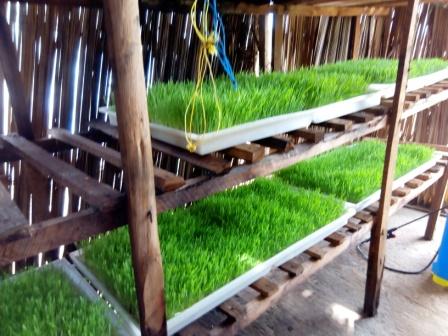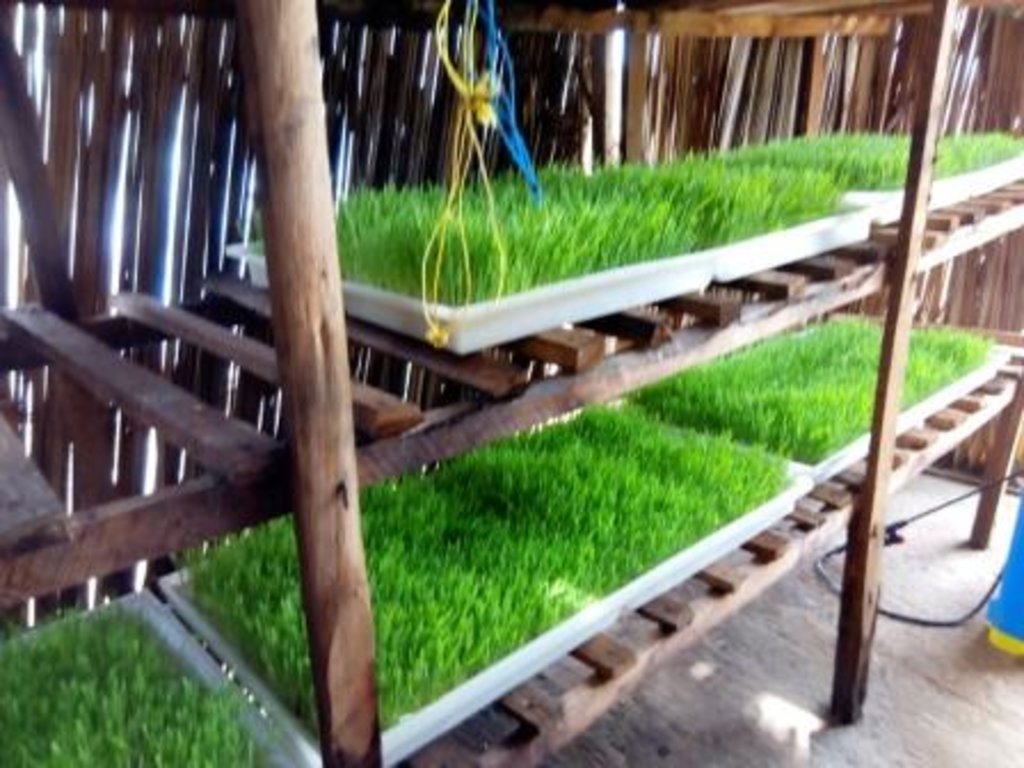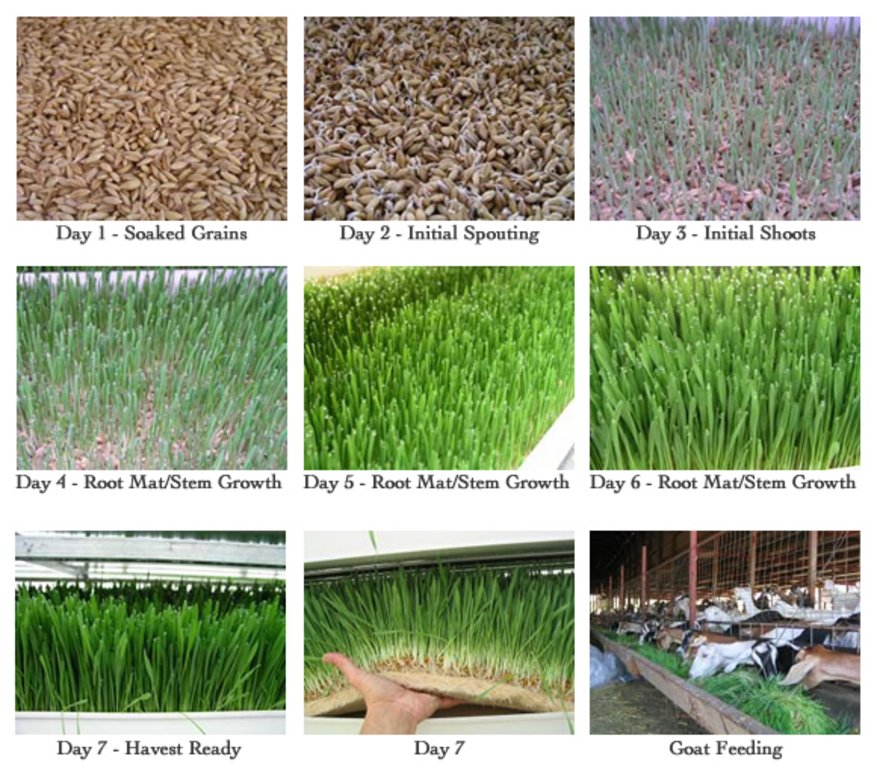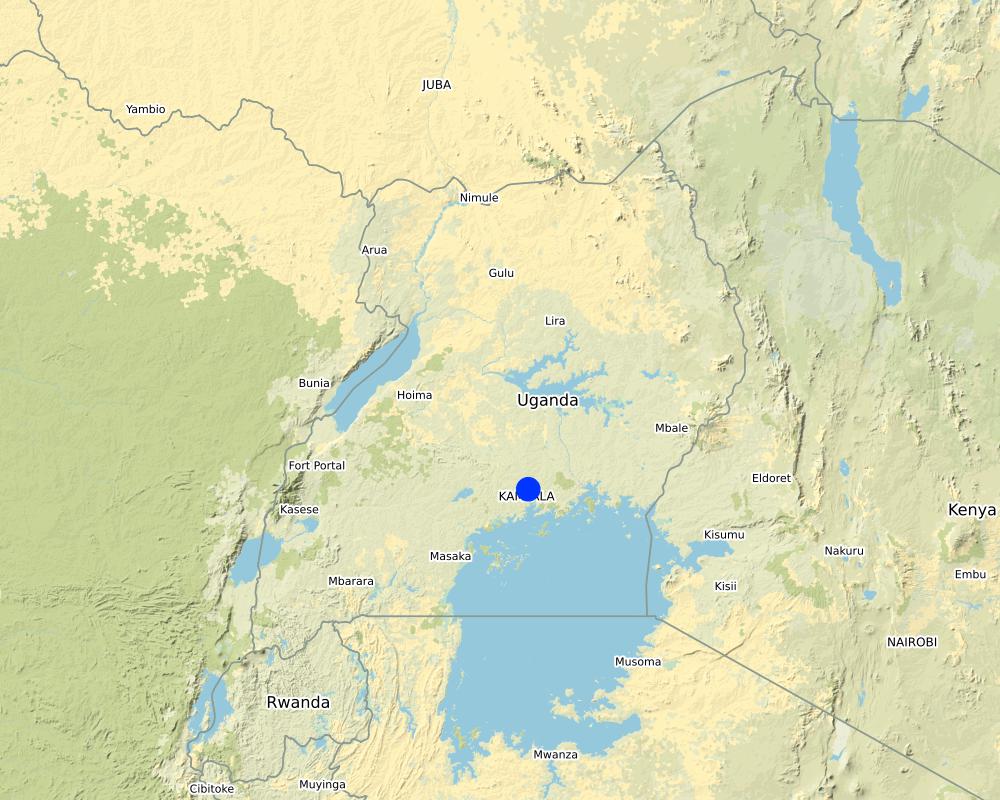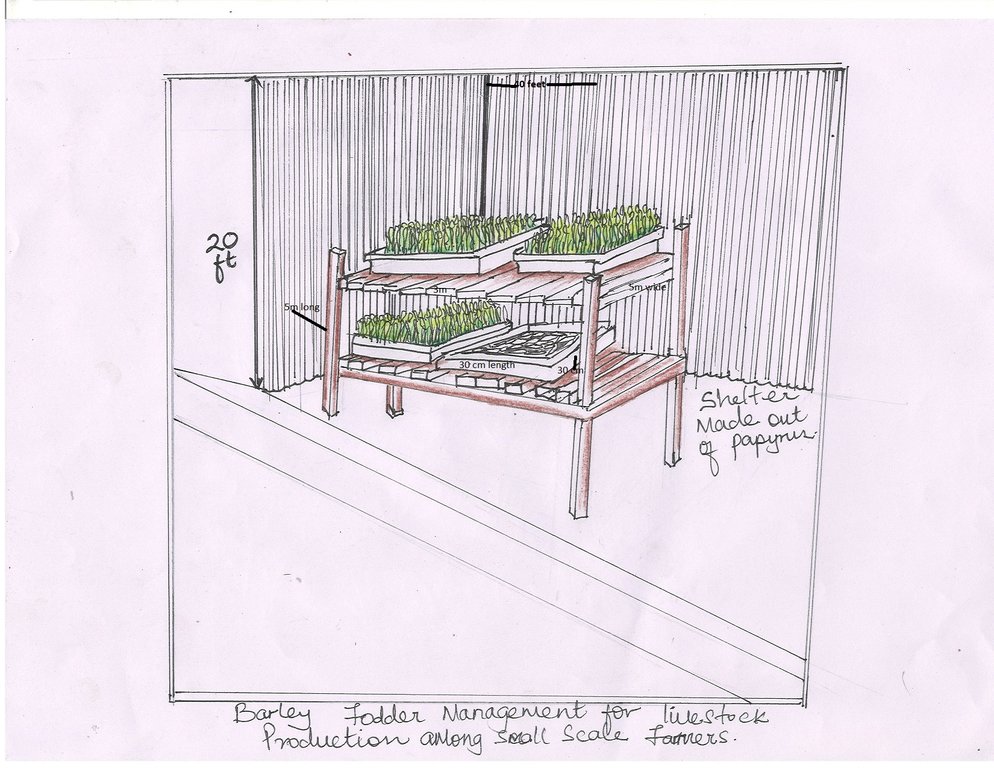Barley fodder management for livestock production among smallholder farmers [اوغندا]
- تاريخ الإنشاء:
- تحديث:
- جامع المعلومات: Sarah Babirye
- المحرر: Kamugisha Rick Nelson
- المراجعون: Nicole Harari, Udo Höggel, Donia Mühlematter
Balle
technologies_3453 - اوغندا
عرض الأقسام
توسيع الكل طي الكل1. معلومات عامة
1.2 تفاصيل الاتصال بالأشخاص الرئيسيين لمصدر المعلومات والمؤسسات المشاركة في تقييم وتوثيق التقنية
الشخص (الأشخاص) الرئيسي لمصدر المعلومات
متخصص في الإدارة المستدامة للأراضي:
Kabanda Fred
0794661269
Kyanja Agricultural Resource Centre
Kyanja Agricultural Research Organizations Gayanza Road ,Parish P.O BOX 7010,KAMPALA
اوغندا
اسم المشروع الذي سهّل توثيق/تقييم التقنية (إذا كان ذلك على صلة)
Scaling-up SLM practices by smallholder farmers (IFAD)اسم المؤسسة (المؤسسات) التي سهلت توثيق/تقييم التقنية (إذا كان ذلك على صلة)
National Agricultural Research Organisation (NARO) - اوغندا1.3 الشروط المتعلقة باستخدام البيانات الموثقة من خلال WOCAT
متى تم تجميع البيانات (ميدانيا)؟:
29/1/2018
يوافق جامع المعلومات والشخص (لاشخاص) الرئيسي لمصدر المعلومات على الشروط المتعلقة باستخدام البيانات الموثقة من خلال WOCAT:
نعم
1.4 إعلان بشأن استدامة التقنية الموصوفة
هل التقنية الموصوفة هنا تمثل مشكلة فيما يتعلق بتدهور الأراضي، بحيث لا يمكن إعلانها تقنية مستدامة لإدارة الأراضي؟:
كلا
التعليقات:
The technology is not problematic with regard to land degradation
2. وصف تقنيةالإدارة المستدامي للأراضي
2.1 وصف مختصر للتقنية
تعريف التقنية:
Barley fodder technology is a livestock feed that grows under a hydroponic system. This green feed is highly palatable, rich in protein and energy yet cost-effective. It takes few days to maturity (5-6 days) and can be grown in a smaller area. One kilogram of barley seeds can yield up to 6 to 6.5 kg of green feed.
2.2 وصف تفصيلي للتقنية
الوصف:
Barley is a cereal grain that grows with hydroponic system to supplement on the feeds for livestock. This system enables crops to grow without soil so easily yet they mature within the shortest time in a smaller area. It is commonly used in finishing rations for livestock. Barley sprouts the best, grows the fastest and is cost-effective. This green feed is less expensive yet highly palatable and nutritious for animals.
To work well for sprouted fodder, the barley seed needs a high germination rate. Sprouting barley consistently and economically needs a climate-controlled space, light (18 hours of light and 6 hours of darkness) and a watering system. The ideal temperature being 75 degrees F and 70% humidity. Air movement is necessary to control mold.
The technology ensures a reduction of pesticides and herbicides because the plants are in a protected environment . The sprouts are high in protein and fiber, and are naturally balanced in protein, fat and energy. Barley fodder has 95% of the energy and higher digestibility hence reducing the occurrence of digestive diseases, such as bloat. It is one of the most nutritious sprouts and is full of essential nutrients, vitamins and minerals. These are absorbed more efficiently due to the lack of enzyme inhibitors in sprouted grain. Dry barley seeds yields between 6-6.5kg of green feed. Feeding barley fodder will improve the overall health and wellbeing of animals. With this technology, farmers can easily anticipate the expected amount of feeds. Despite the benefits, growing barley requires skills, knowledge and constant supervision especially maintaining the conditions required. Barley seeds are at times hard to get. In case of commercial/large livestock farming, the technology is not economically feasible. Bacterial and fungal growth is also another challenge like the common bread mould therefore seeds must be sterilized. The steps taken to grow barley seeds are as follows:
•On day 1, the barley seeds are laid on plastic trays after being soaked in water for 8-12 hours or an overnight. These seeds must be moist and kept clean. In case of any moulds, hydrogen peroxide may be used in the soaking water to kill mould.
•On day 2, the trays are placed on shelves where they are stacked. On this day, initial sprouting begins. Seeds must be kept moist, but not water-logged. Manually, water should be spread every after 4-5 hours. The seeds will usually sprout within 24 hours.
•On the third day, initial shooting begins. Watering still proceeds.
•From the 4-5th day, the root mat or the mat stem begin to grow.
•On the 6-7 the day, the farmers begins to harvest the barley grass and gives to the livestock. The grass has produced a 6-8 inch high grass mat with a 2 inch mat of interwoven roots.
The sprouted grain is harvested by removing the tray or sliding the mat off the tray in one long sheet. The mats can be cut to the appropriate size and fed to animals. Livestock will eat the whole thing like seeds, roots, and grass therefore, there is minimal waste. Barley is a major feeding option when pastureland and/or hay are in short supply, or adds a highly nutritious and relished supplement to traditional grazing.
Initial costs involved to a small scale farmer are minimal. This includes buying clean seeds, 5 kg costing 15,000/=, 10 plastic trays (50000), 2 watering cans (20000), 1 bucket for soaking seeds (10000), watering seeds 6 times (18000), soaking seeds (3000), labour for making shelves (30000), papyrus mat (20000) ,2 kg of nails (10000), timber for making shelves (50000), chopping ready folder (3000) totalling to 232,000/= for a start. However, this depends on the amount of fodder a farmer wants to produce.
A kg of barley seeds yields to 7-10 kg of green fodder. Each kg of fodder is sold at 1500 hence in a kg planted (i.e. 3000 invested), a farmer is likely to earn 15000/=
The technology is advantageous in that there is little or insignificant costs involved on maintenance of the technology. Maintenance only involves daily watering of seeds (18000 for 6 days), cleaning the treys after use (3000) and supervision on barley during growing for 6 days (18000) totaling to 39000/=.
2.3 صور التقنية
2.4 فيديوهات عن التقنية
التاريخ:
29/01/2018
الموقع:
Kyanja Agricultural Resource Centre
اسم مصور الفيديو:
Babirye Sarah
2.5 البلد/المنطقة/المواقع التي تم تنفيذ التقنية فيها والتي يغطيها هذا التقييم
البلد:
اوغندا
المنطقة/الولاية/المحافظة:
KAMPALA
مزيد من التفاصيل حول الموقع:
Kyanja, Gayaza
Map
×2.6 تاريخ التنفيذ
في حالة عدم معرفة السنة بالتحديد، يرجى الإشارة إلى التاريخ التقريبي:
- منذ أقل من 10 سنوات (مؤخرًا)
2.7 إدخال التقنية
حدد كيف تم إدخال التقنية:
- أثناء التجارب/الأبحاث
3. تصنيف تقنية الإدارة المستدامي للأراضي
3.1 الغرض الرئيسي ( الأغراض الرئيسية) للتقنية
- تحسين الإنتاج
- خلق أثر اقتصادي مفيد
3.2 نوع (أنواع) استخدام الأراضي الحالية حيث يتم تطبيق التقنية

غير ذلك
حدد:
Laboratory
ملاحظات:
The demonstration was done at Kyanja National Research Organization in a laboratory.
3.3 مزيد من المعلومات حول استخدام الأراضي
إمدادات المياه للأرض التي يتم تنفيذ التقنية عليها:
- مختلط بعلي-مروي
التعليقات:
Water can be collected from national water (water supplied to people by the government of Uganda, National Water and Sewage Cooperation). Water from rainfall is be used in the process.
حدد:
Not seseonal, can be grown any time
3.4 مجموعةالإدارة المستدامة للأراضي التي تنتمي إليها هذه التقنية
- الإدارة المتكاملة للمحاصيل والثروة الحيوانية
- الحد الأدنى من اختلال التربة
3.5 انتشار التقنية
حدد انتشار التقنية:
- يتم تطبيقها في نقاط محددة/ تتركز على مساحة صغيرة
التعليقات:
Basically after building a structure with shelves, barley seeds are planted into trays.
3.6 التدابير التقنية في مجال إلادارة المستدامة للأراضي

التدابير الإدارية
- M2: تغيير في مستوى الإدارة/الكثافة
التعليقات:
Barley seeds are cleaned before being planted to avoid the risks of fungal attack e.g moulds
3.7 الأنواع الرئيسية من تدهور الأراضي التي تناولتها التقنية

آخر
التعليقات:
Not applicable
3.8 منع أو حد أو عكس تدهور الأراضي
تحديد هدف التقنية فيما يتعلق بتدهور الأراضي:
- غير قابل للتطبيق
4. المواصفات الفنية، وأنشطة التنفيذ، والمدخلات، والتكاليف
4.1 الرسم الفني للتقنية
4.2 المواصفات الفنية/شروحات الرسم الفني
The shelter is constructed at 20 feet long and 20 feet wide
Trays(10) of 30cm wide and 30 cm length
Barley seeds (5kg)
Shelves (20) of 3m wide and 3m long
Papyrus mats (2) of 20 feet wide and 40 feet long
Shelves stand of 5m long
4.3 معلومات عامة بخصوص حساب المدخلات والتكاليف
حدد كيفية احتساب التكاليف والمدخلات:
- لكل وحدة تقنية
حدد الحجم والطول وما إلى ذلك (إذا كانت ذات صلة):
20feet long*20feet wide
عملة أخرى/ عملة وطنية (حدد):
UGX
أشر إلى سعر الصرف من الدولار الأمريكي إلى العملة المحلية (إذا كان ذا صلة): 1 دولار أمريكي =:
3600,0
اذكر متوسط تكلفة أجر العمالة المستأجرة في اليوم الواحد:
3000/= per day
4.4 أنشطة التأسيس
| النشاط | نوع التدبير | التوقيت | |
|---|---|---|---|
| 1. | Buying seeds | تدابير أخرى | Every planting time |
| 2. | Clean the seeds if dirty to avoid molds | إدارية | Before planting if they are dirty |
| 3. | Soak the seeds for 8-12 hours | إدارية | 8-12 hours |
| 4. | Place the trays on the shelves | إدارية | Once from 1-5 day |
| 5. | Water the seeds planted on the tray every 4-8 hours | إدارية | 4-8 hours for 5 days after planting |
| 6. | Harvest and chop the leaves,stems and roots,then give to the livestock | زراعية | After harvesting |
4.5 التكاليف والمدخلات اللازمة للتأسيس
| تحديد المدخلات | الوحدة | الكمية | التكاليف لكل وحدة | إجمالي التكاليف لكل مدخل | % من التكاليف التي يتحملها مستخدمو الأراضي | |
|---|---|---|---|---|---|---|
| العمالة | Making shelves | Man day | 1,0 | 30000,0 | 30000,0 | |
| العمالة | Clean the seeds if they are dirty | Man day | 1,0 | 3000,0 | 3000,0 | |
| العمالة | Soaking the seeds into water | Man day | 1,0 | 3000,0 | 3000,0 | |
| العمالة | Chop the fodder ready for feeding | Man day | 1,0 | 3000,0 | 3000,0 | |
| معدات | Water the seeds planted on the trey in every 4-8 hours | Man day | 6,0 | 3000,0 | 18000,0 | |
| معدات | Buying trays | piece | 10,0 | 5000,0 | 50000,0 | |
| المواد النباتية | Buying seeds | Kg | 5,0 | 3000,0 | 15000,0 | |
| المواد النباتية | Buying a watering can | piece | 2,0 | 10000,0 | 20000,0 | |
| المواد النباتية | Buying a bucket | piece | 1,0 | 10000,0 | 10000,0 | |
| مواد البناء | Timber making shelves | piece | 5,0 | 10000,0 | 50000,0 | |
| مواد البناء | Nails | Kg | 2,0 | 5000,0 | 10000,0 | |
| مواد البناء | Papyrus mats | piece | 2,0 | 10000,0 | 20000,0 | |
| إجمالي تكاليف إنشاء التقنية | 232000,0 | |||||
إذا تحمل مستخدم الأرض أقل من 100% من التكاليف، حدد من قام بتغطية التكاليف المتبقية:
All costs are covered by the Resource Centre
التعليقات:
The costs are estimated.
4.6 الصيانة/الأنشطة المتكررة
| النشاط | نوع التدبير | التوقيت/الوتيرة | |
|---|---|---|---|
| 1. | Watering the seeds | زراعية | Every day after planting to harvest |
| 2. | Maintaining the room temperature | زراعية | Every day after planting to harvest |
| 3. | Replacing poles | بنيوية أو هيكلية | Once a year |
| 4. | Cleaning the equipments like treys | تدابير أخرى | After harvesting |
| 5. | Replacement of shelves | بنيوية أو هيكلية | Once a year |
التعليقات:
Maintenance activities are few. Equipments are only replaced when damaged which can take a year.
4.7 التكاليف والمدخلات اللازمة للصيانة/للأنشطة المتكررة (سنويًا)
| تحديد المدخلات | الوحدة | الكمية | التكاليف لكل وحدة | إجمالي التكاليف لكل مدخل | % من التكاليف التي يتحملها مستخدمو الأراضي | |
|---|---|---|---|---|---|---|
| العمالة | Watering seeds | Man day | 6,0 | 3000,0 | 18000,0 | |
| العمالة | Cleaning the equipments( trays) | Man day | 1,0 | 3000,0 | 3000,0 | |
| معدات | Spervision of the growing barley | Man day | 6,0 | 3000,0 | 18000,0 | |
| إجمالي تكاليف صيانة التقنية | 39000,0 | |||||
إذا تحمل مستخدم الأرض أقل من 100% من التكاليف، حدد من قام بتغطية التكاليف المتبقية:
The Resource Centre caters for all the costs.
التعليقات:
These are estimated but almost in the range. This makes the technology more cost efficient.
4.8 أهم العوامل المؤثرة على التكاليف
قدم وصفا لأهم العوامل التي تؤثر على التكاليف:
Labour costs represent the largest cost element.
5. البيئة الطبيعية والبشرية
5.1 المناخ
هطول الأمطار السنوي
- < 250 مم
- 251- 500 ملم
- 501 - 750ملم
- 1,000-751 ملم
- 1,500-1,100 ملم
- 2,000-1,500 ملم
- 3,000-2,001 ملم
- 4,000-3,100 ملم
- > 4000 ملم
المنطقة المناخية الزراعية
- شبه رطبة
5.2 طوبوغرافيا
متوسط الانحدارات:
- مسطح (0-2%)
- بسيط (3-5%)
- معتدل (6-10%)
- متدحرج (11-15%)
- تلال (16-30%)
- شديدة الانحدار(31-60%)
- فائقة الانحدار (>60%)
التضاريس:
- هضاب/سهول
- أثلام مرتفعة
- المنحدرات الجبلية
- منحدرات التلال
- منحدرات في السفوح
- قاع الوادي
المنطقة الارتفاعية:
- 100-0 متر فوق سطح البحر
- 500-101 متر فوق سطح البحر
- 1,000-501 متر فوق سطح البحر
- 1,500-1,001 متر فوق سطح البحر
- 2,000-1,501 متر فوق سطح البحر
- 2,500-2,100 متر فوق سطح البحر
- 3,000-2,501 متر فوق سطح البحر
- 4,000-3,001 متر فوق سطح البحر
- > 4000 متر فوق سطح البحر
وضح ما إذا كانت التقنية مطبقة على وجه التحديد في:
- غير ذات صلة
5.3 التربة
متوسط عمق التربة:
- ضحل جدًا (0-20 سم)
- ضحلة (21-50 سم)
- متوسطة العمق (51-80 سم)
- عميقة (81-120 سم)
- عميقة جدًا (> 120 سم)
قوام التربة (التربة السطحية):
- متوسط ( طميي، سلتي)
قوام التربة (> 20 سم تحت السطح):
- متوسط ( طميي، سلتي)
المواد العضوية في التربة السطحية:
- متوسطة (1-3%)
5.4 توافر المياه ونوعيتها
منسوب المياه الجوفية:
< 5 م
توافر المياه السطحية:
جيد
نوعية المياه (غير المعالجة):
مياه شرب جيدة
هل تعتبر ملوحة الماء مشكلة؟:
كلا
هل تحدث فيضانات في المنطقة؟:
كلا
5.5 التنوع البيولوجي
تنوع الأنواع:
- متوسط
تنوع الموائل:
- متوسط
5.6 خصائص مستخدمي الأراضي الذين يطبقون التقنية
مستقر أو مرتحل:
- غير المترحل
التوجه السوقي لنظام الإنتاج:
- مختلط (كفاف/ تجاري)
الدخل من خارج المزرعة:
- 10-50% من جميع الإيرادات
المستوى النسبي للثروة:
- متوسط
أفراداً أو مجموعات:
- موظف (شركة، حكومة)
مستوى المكننة:
- عمل يدوي
الجنس:
- رجال
عمر مستخدمي الأرضي:
- شباب
5.7 متوسط مساحة الأرض المملوكة أو المستأجرة من قبل مستخدمي الأراضي الذين يطبقون التقنية
- < 0.5 هكتارا
- 0.5 - 1 هكتار
- 1 -2 هكتار
- 2 - 5 هكتار
- 5 - 15 هكتار
- 15 - 50 هكتار
- 50 - 100هكتار
- 500-100 هكتار
- 1,000-500 هكتار
- 10,000-1,000 هكتار
- > 10,000 هكتار
هل يعتبر هذا نطاقًا صغيرًا أو متوسطًا أو واسعا (في إشارة إلى السياق المحلي)؟:
- على نطاق صغير
5.8 ملكية الأراضي، وحقوق استخدام الأراضي، وحقوق استخدام المياه
ملكية الارض:
- دولة
حقوق استخدام الأراضي:
- مؤجر
حقوق استخدام المياه:
- مؤجر
5.9 الوصول إلى الخدمات والبنية التحتية
الصحة:
- ضعيف
- معتدل
- جيد
التعليم:
- ضعيف
- معتدل
- جيد
المساعدة التقنية:
- ضعيف
- معتدل
- جيد
العمل (على سبيل المثال خارج المزرعة):
- ضعيف
- معتدل
- جيد
الأسواق:
- ضعيف
- معتدل
- جيد
الطاقة:
- ضعيف
- معتدل
- جيد
الطرق والنقل:
- ضعيف
- معتدل
- جيد
مياه الشرب وخدمات الصرف الصحي:
- ضعيف
- معتدل
- جيد
الخدمات المالية:
- ضعيف
- معتدل
- جيد
6. الآثار والتصريحات الختامية
6.1 الآثار التي أظهرتها التقنية في الموقع
الآثار الاجتماعية والاقتصادية
الإنتاج
جودة العلف
التعليقات/ حدد:
Improves on fodder for animals. That is 1 kg of barley yields 7-10 kg of green fodder
إنتاج حيواني
التعليقات/ حدد:
The animals that feed on barley supplements reduced suffering from bloating because of high digestibility
تنوع المنتج
التعليقات/ حدد:
Barley is a supplement to the conventional grass
منطقة الإنتاج
التعليقات/ حدد:
It requires a small production area
إدارة الأراضي
التعليقات/ حدد:
Land well managed
الدخل والتكاليف
دخل المزرعة
التعليقات/ حدد:
Barley grass is highly nutritious with a lot of protein content. Coupled with being a very palatable fodder, the growth rate of animals increases.
تنوع مصادر الدخل
التعليقات/ حدد:
One kg of harvested green fodder is sold between 1500-2000/= hence increase in income to a farmer
الآثار الاجتماعية والثقافية
الوضع الصحي
التعليقات/ حدد:
The health situations of animals is improved. Barley fodder has 95% of the energy and higher digestibility hence reducing the occurrence of digestive diseases, such as bloat. It is one of the most nutritious sprouts and is full of essential nutrients, vitamins and minerals.
6.2 الآثار التي أظهرتها التقنية خارج الموقع
توافر المياه
التعليقات/ حدد:
The technology requires enough supply of water for watering the growing barley
6.3 تعرض التقنية وحساسيتها لتغير المناخ التدريجي والظواهر المتطرفة/الكوارث المرتبطة بالمناخ (كما يراها مستخدمو الأراضي)
الظواهر المتطرفة / الكوارث المرتبطة بالمناخ
الكوارث المناخية
| كيف تتعامل التقنية مع ذلك؟ | |
|---|---|
| جفاف | ليس جيدا على الاطلاق |
الكوارث البيولوجية
| كيف تتعامل التقنية مع ذلك؟ | |
|---|---|
| الإصابة بالحشرات/الديدان | ليس جيدا على الاطلاق |
الظواهر المتطرفة الأخرى المرتبطة بالمناخ (الكوارث)
| أخرى (حدد) | كيف تتعامل التقنية مع ذلك؟ |
|---|---|
| Too high temperature | ليس جيدا على الاطلاق |
6.4 تحليل التكلفة والعائد
كيف يمكن مقارنة العوائد نسبة لتكاليف الإنشاء (من وجهة نظر مستخدمي الأراضي)؟
عوائد قصيرة الأجل:
ايجابي جدا
عوائد طويلة الأجل:
ايجابي جدا
كيف تتم مقارنة العوائدمع كلفة الصيانة/التكاليف المتكررة (من وجهة نظر مستخدمي الأراضي)؟
عوائد قصيرة الأجل:
ايجابي جدا
عوائد طويلة الأجل:
ايجابي جدا
6.5 اعتماد التقنية
- 50-10%
من بين جميع الذين تبنوا التقنية، كم عدد الذين فعلوا ذلك بشكل تلقائي، أي دون تلقي أي حوافز مادية/مدفوعات؟:
- 50-10%
6.6 التكيف
هل تم تعديل التقنية مؤخرًا لتتكيف مع الظروف المتغيرة؟:
نعم
إذا كانت الإجابة بنعم، وضح الظروف المتغيرة التي تم تكييفها معها:
- تغير المناخ / التطرف
حدد تكيف التقنية(التصميم، المواد/الأنواع، الخ.):
It is operated in a moist, cool environment
6.7 نقاط القوة / المزايا / الفرص التي توفرها التقنية
| نقاط القوة/ المزايا/ الفرص من وجهة نظر مستخدمي الأراضي |
|---|
| It is less cost effective yet highly nutritious. A kg of barley is nutritionally equivalent to 3Kg of other grass like the lucerne. |
| Barley grows in a very short period of time |
| It requires a small piece of area to grow barley |
| نقاط القوة/ المزايا/ الفرص من وجهة نظر جامع المعلومات أو غيره من الاشخاص الرئيسيين لمصدر المعلومات |
|---|
| Barley improves the overall health and well-being of animals |
| It has higher digestibility hence reduces on some diseases like bloat |
| Barley growing does not involve the use of soil hence cost effective |
6.8 نقاط ضعف / مساوىء / مخاطر التقنية وسبل التغلب عليها
| نقاط الضعف/ المساوىء/ المخاطر من وجهة نظر مستخدم الأراضي | كيف يمكن التغلب عليها؟ |
|---|---|
| The technology requires skills and knowledge especially to manage the conditions for growth | Encouraging farmers to train from model farmers |
| Barley seeds are at times hard to get. | Promoting the barley seed multiplication in large quantities |
| The technology requires maximum supervision | Always endeavor to do maximum supervision |
| نقاط الضعف/ المساوىء/ المخاطر من وجهة نظر جامع المعلومات أو غيره من الاشخاص الرئيسيين لمصدر المعلومات | كيف يمكن التغلب عليها؟ |
|---|---|
| Bacterial and fungal growth is also another challenge e.g the common bread mould. | Seeds must be sterilized |
| Barley is not economically feasible for large scale farmers on pasture production | To grow more pastures in addition to barley as feed supplements |
| It cannot be stored for a long period of time | Serve it in the first days after harvest. |
7. المراجع والروابط
7.1 طرق جمع/مصادر المعلومات
- زيارات ميدانية، مسوحات ميدانية
2
- مقابلات مع مستخدمي الأراضي
2
- مقابلات مع المتخصصين/الخبراء في الإدارة المستدامة للأراضي
7.2 المراجع للمنشورات المتاحة
العنوان، المؤلف، السنة، النظام القياسي الدولي لترقيم الكتب ISBN:
Growing Sprouted Fodder For Livestock by Jason Wiskerchen Monday, March 19, 2012,
متاح من أين؟كم التكلفة؟:
https://www.peakprosperity.com/growing-sprouted-fodder-for-livestock-2/
7.3 روابط للمعلومات ذات الصلة المتوفرة على الإنترنت
العنوان/الوصف:
https://www.hydroponics-simplified.com/hydroponic-fodder-advantages.html
عنوان الرابط URL:
http://www.fodderconsultants.com/advantages.html
الروابط والوحدات المواضيعية
توسيع الكل طي الكلالروابط
لا يوجد روابط
الوحدات المواضيعية
لا يوجد وحدات مواضيعية


